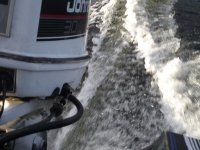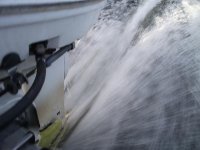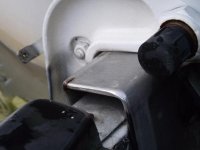SomeRandomDude
New member
I have a Johnson 1990 30 HP motor on a peterbourough jetstar boat. I will describe the problem best i can and i do have pictures of when it does or does not cavitate.
Normal rooster tail

When the rooster tail appears like this, kinda flat, I can go any speed without cavitating.
Weird spray coming from motor

If I hit a wave or corner tightly, the motor begins to have a weird spray coming up and out from it as you can kind of see from this picture. If I go full speed while this is happening, the motor will cavitate and shoot up to 5000 RPM. The only way to stop the spray or the cavition is to slow right down and out of plane and speed up again.
Metal plate

My motor is mounted on a metal plate to help the transom. However, this plate needed to be mounted about 1 or so inches higher than the transom so it would not cover the hole that allows water to flow out of the well.
Putting the motor down one notch down does keep this from happening but the angle is puts the motor at is not good. There is much drag from the motor and it works too hard for the speed it goes. It goes 5 mph faster with this level which by the way is the middle hole, 3 from the top and bottom of the 5 trim holes. Lowering the plate and motor can be done but it would be hard because the plate and motor are bolted right through the transom. It would also be hard to modify the plate to allow water out of the well.
So my question is, is there anything I can do to stop this from happening other than finding a way to lower the plate? Would lowering it even make a difference?
Any suggestion would be greatly appreciated.
Normal rooster tail

When the rooster tail appears like this, kinda flat, I can go any speed without cavitating.
Weird spray coming from motor

If I hit a wave or corner tightly, the motor begins to have a weird spray coming up and out from it as you can kind of see from this picture. If I go full speed while this is happening, the motor will cavitate and shoot up to 5000 RPM. The only way to stop the spray or the cavition is to slow right down and out of plane and speed up again.
Metal plate

My motor is mounted on a metal plate to help the transom. However, this plate needed to be mounted about 1 or so inches higher than the transom so it would not cover the hole that allows water to flow out of the well.
Putting the motor down one notch down does keep this from happening but the angle is puts the motor at is not good. There is much drag from the motor and it works too hard for the speed it goes. It goes 5 mph faster with this level which by the way is the middle hole, 3 from the top and bottom of the 5 trim holes. Lowering the plate and motor can be done but it would be hard because the plate and motor are bolted right through the transom. It would also be hard to modify the plate to allow water out of the well.
So my question is, is there anything I can do to stop this from happening other than finding a way to lower the plate? Would lowering it even make a difference?
Any suggestion would be greatly appreciated.
Last edited:

